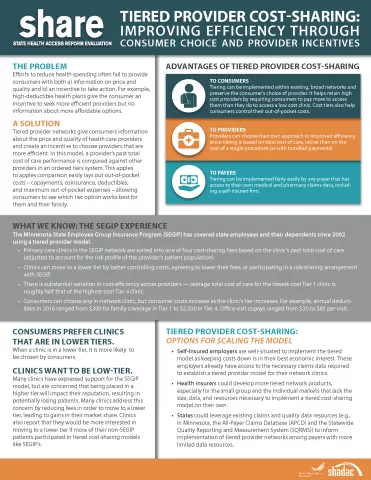The Minnesota State Employee Group Insurance Program (SEGIP) has covered Minnesota state employees and their dependents using a tiered provider model since 2002. A recent SHARE-funded analysis led by Dr. Bryan Dowd (University of Minnesota) examined the SEGIP tiering model as well as patient and clinic responses to this tiered provider network approach. The following blog provides a high-level overview of findings from this analysis.
Background: Tiered Provider Cost-Sharing
The Problem
Efforts to reduce health spending often fail to provide consumers with both (a) information on price and quality and (b) an incentive to take action. For example, high-deductible health plans give the consumer an incentive to seek more efficient providers but no information about more affordable options.
The Solution
Tiered provider networks offer a solution to this problem by giving consumers information about the price and quality of health care providers and creating an incentive to choose providers that are more efficient. In this model, a provider's past total cost of care performance is compared against other providers in an ordered tiers system. This apples-to-apples comparison easily lays out out-of-pocket costs--copayments, coinsurance, deductibles, and maximum out-of-pocket expenses--allowing consumers to see which tier option works best for them and their family.
Advantages of Tiered Provider Cost-Sharing
- To Consumers
Tiering can be implemented within existing, broad networks and preserve the consumer's choice of provider. - To Providers
Tiering helps retain high cost providers by requiring consumers to pay more to access them than they do to access a low-cost clinic. Cost tiers also help consumers control their out-of-pocket costs. Providers benefit because they can choose their own approach to improved efficiency since tiering is based on total cost of care, rather than on the cost of a single procedure (as with bundled payments). - To Payers
Tiering can be implemented fairly easily by an payer that has access to their own medical and pharmacy claims data, including a self-insured firm.
What We Know: The SEGIP Experience
SEGIP has covered Minnesota state employees and their dependents since 2002 using a tiered provider model.
- Primary care clinics in the SEGIP network are sorted into one of four cost-sharing tiers based on the clinic's past total cost of care (adjusted to account for the risk profile of the provider's patient population).
- Clinics can move to a lower tier by better controlling costs, agreeing to lower their fees, or participating in a risk-sharing arrangement with SEGIP.
- There is substantial variation in cost-efficiency across participating providers, with the average total cost of care for the lowest-cost Tier 1 clinic being roughly half that of the highest-cost Tier 4 clinic.
- Consumers can choose any in-network clinic, but consumer costs increase as the clinic's tier increases. For example, annual deductibles in 2016 ranged from $300 for family coverage in Tier 1 to $2,500 in Tier 4. Office copays ranged from $30 to $85 per visit.
What We Learned from SEGIP
The research team found that:
- Customers prefer clinics that are in lower tiers. When a clinic is in a lower tier, it is more likely to be chosen by consumers.
- Clinics want to be low-tier. Many clinics have expressed support for the SEGIP model but are concerned that being placed in a higher tier will impact their reputation, resulting in potentially losing patients. Many clinics address this concern by reducing fees in order to move to a lower tier, leading to gains in their market share. Clinics also report that they would be more interested in moving to a lower tier if more of their non-SEGIP patients participated in tiered cost-sharing models like SEGIP's.
Tiered Provider Cost-Sharing: Options for Scaling the Model
- Self-insured employers are well-situated to implement the tiered model as keeping costs down is in their best economic interest. These employers already have access to the necessary claims data required to establish a tiered provider model for their network clinics.
- Health insurers could develop more tiered network products, especially for the small group and the individual markets that lack the size, data, and resources necessary to implement a tiered cost-sharing model on their own.
- States could leverage existing claims and quality data resources (e.g., in Minnesota, the All-Payer Claims Database (APCD) and the Statewide Quality Reporting and Measurement System (SQRMS)) to inform implementation of tiered provider networks among payers with more limited data resources.

